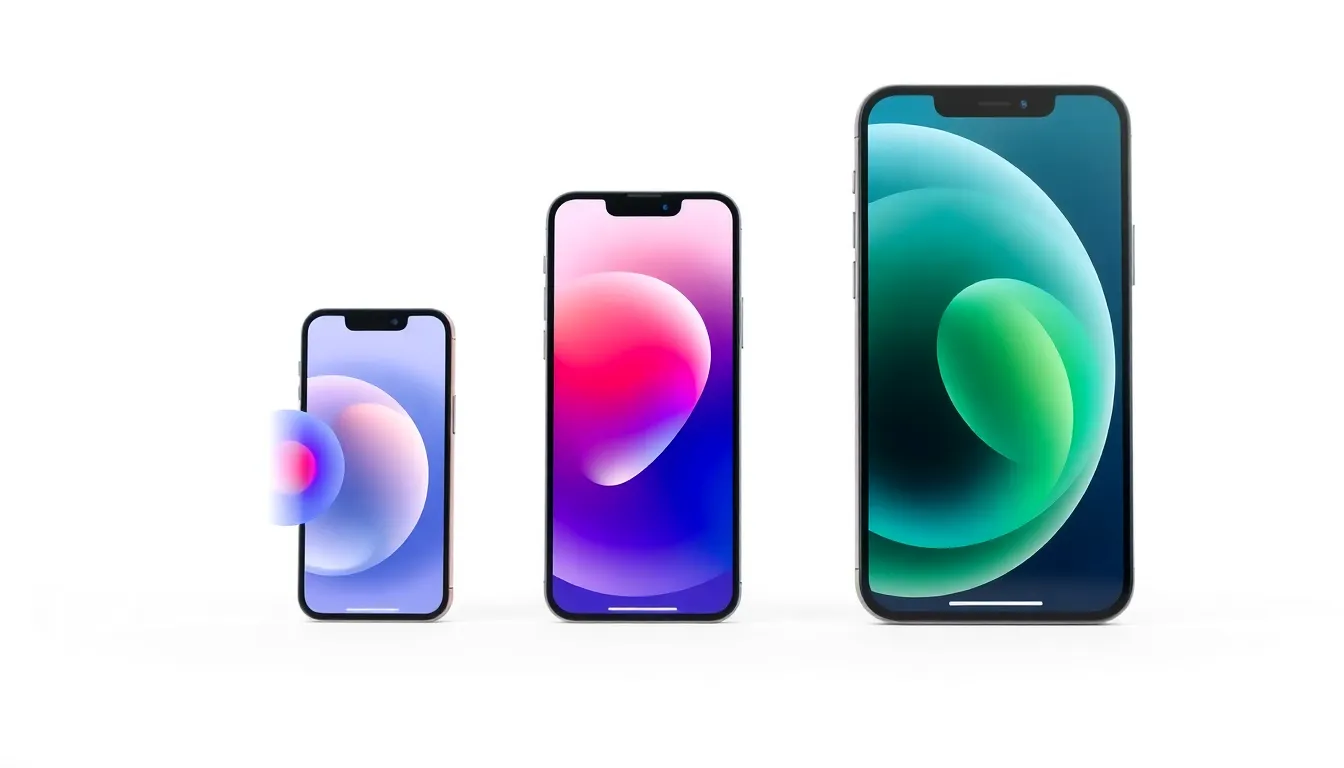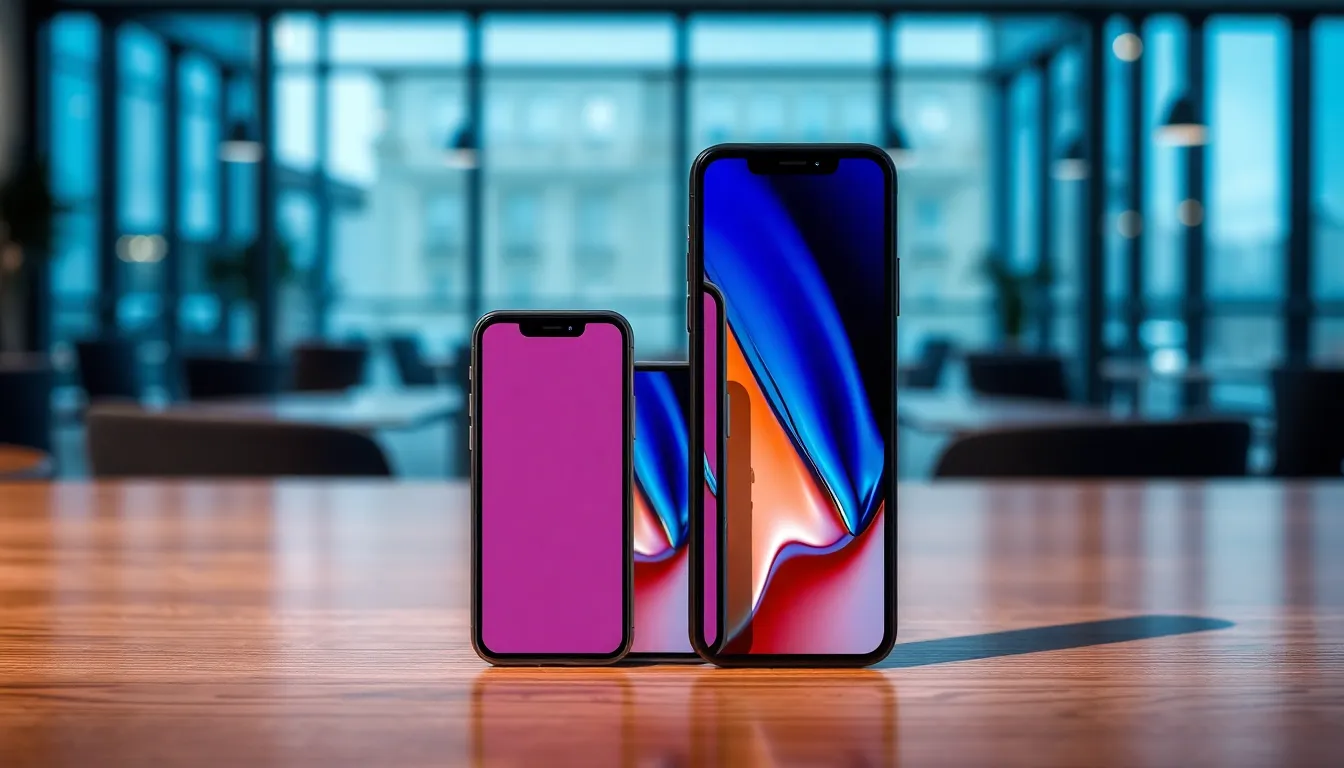When it comes to smartphones, size matters—especially when it comes to that sleek iPhone screen. Whether you’re binge-watching your favorite series or scrolling through endless cat memes, the right screen size can make all the difference. But with so many models out there, it’s easy to feel like you’re lost in a sea of numbers and inches.
Table of Contents
ToggleOverview of iPhone Screen Sizes
iPhone screen sizes vary across generations, influencing user experience significantly. Knowing these sizes helps consumers choose devices that suit their preferences.
Historical Context of iPhone Screen Sizes
The original iPhone featured a 3.5-inch display, setting the standard for early smartphones. In 2010, the iPhone 4 introduced a 3.5-inch Retina display, enhancing clarity. The iPhone 6 and 6 Plus marked a shift toward larger screens, offering 4.7 inches and 5.5 inches, respectively. Subsequent models expanded on this trend, with the iPhone X debuting a 5.8-inch screen. Currently, the latest models range from 6.1 inches to 6.7 inches, reflecting growing consumer demand for more immersive experiences.
Evolution of Screen Technology
Screen technology has advanced significantly in iPhones over the years. The introduction of Retina technology dramatically improved image quality, making text and images sharper. OLED screens replaced LCD in newer models, providing deeper blacks and more vibrant colors. Alongside these advancements, True Tone technology now adjusts screen color based on ambient light, enhancing readability. Current iPhones utilize Ceramic Shield for added durability, ensuring screens withstand everyday wear and tear. Overall, these technological enhancements have continuously improved user interaction with the device.
Current iPhone Models and Their Screen Sizes

Apple offers a variety of current iPhone models, each with distinct screen sizes. These sizes cater to different preferences and usage scenarios, enhancing usability and viewing experience.
Comparison of Recent Models
iPhone 14 features a 6.1-inch display, offering a balance of portability and functionality. For those who prefer a larger screen, the iPhone 14 Pro Max has a 6.7-inch display, providing an immersive experience for gaming and media consumption. The iPhone 13 Mini offers a more compact option with a 5.4-inch screen, appealing to users seeking a lightweight design. Differences in display sizes often influence user choice, reflecting varying lifestyle needs.
Specifications of Each Screen Size
The 5.4-inch iPhone 13 Mini supports Super Retina XDR technology, ensuring vibrant colors and high contrast. Apple’s 6.1-inch iPhone 14 also utilizes Super Retina XDR, providing enhanced clarity and brightness for everyday use. Users of the 6.7-inch iPhone 14 Pro enjoy ProMotion technology, allowing for smoother scrolling and responsiveness. Each model’s specifications contribute to its overall performance, highlighting how screen size impacts the overall user experience.
Measuring iPhone Screen Sizes
Understanding how iPhone screen sizes measure provides insight into their functionality. Manufacturers define screen size by measuring diagonally from one corner to the opposite corner. This measurement indicates the visible display area, excluding bezels and borders.
How Screen Size is Measured
Screen size measurement uses inches for clarity. To determine the screen size, one measures the distance diagonally from the top left to the bottom right corner. This method applies consistently across iPhone models. Different iPhone versions feature various screen sizes, with the latest models reaching up to 6.7 inches. By knowing the specific size, consumers can choose devices that fit their preferences and usage habits.
Importance of Aspect Ratio
Aspect ratio plays a crucial role in screen design. This ratio describes the width compared to height, typically expressed as two numbers separated by a colon. Many iPhones feature an aspect ratio of 19.5:9, enhancing multimedia experiences. A wider aspect ratio supports better video playback and immersive gaming. Selecting a device with the right aspect ratio ensures that users fully enjoy their content without distortion or cropping. This choice affects viewing comfort and overall satisfaction.
User Experience and Screen Size
Screen size significantly influences user experience across various activities on the iPhone, such as streaming or gaming. Larger screens offer enhanced visibility and engagement, providing an immersive experience during video playback. Text readability improves on larger displays, reducing eye strain and facilitating comfortable use during long sessions. For tasks like browsing and multitasking, ample screen real estate enhances productivity by allowing users to view more content simultaneously.
Impact on Usability
Usability relates directly to screen dimensions and technology. Smaller screens may limit interactive elements, while larger sizes accommodate more comprehensive interfaces. Users often find that they navigate applications with greater ease on larger screens, resulting in increased satisfaction. Apple’s offerings cater to diverse user needs with their varying screen sizes, from the compact iPhone 13 Mini to the expansive iPhone 14 Pro Max.
Screen Size Preference Among Users
User preferences vary widely when it comes to screen size. Compact devices appeal to individuals seeking portability that fits into pockets or small bags. Conversely, many users gravitate towards larger displays for rich media consumption and enhanced gaming experiences. Surveys indicate high satisfaction rates for users owning larger models, as these provide immersive viewing and usability advantages. Choices regarding screen size often stem from lifestyle and usage habits, highlighting the need for Apple’s diverse range.
Choosing the right iPhone screen size is essential for maximizing the user experience. With options ranging from the compact 5.4-inch iPhone 13 Mini to the immersive 6.7-inch iPhone 14 Pro Max, there’s a model to suit every preference. The advancements in display technology continue to enhance clarity and durability, making it easier for users to enjoy streaming, gaming, and everyday tasks. Understanding the impact of screen size on usability can guide consumers in selecting the perfect device that aligns with their lifestyle. Whether prioritizing portability or seeking a larger display for media consumption, Apple’s diverse offerings ensure satisfaction across the board.




